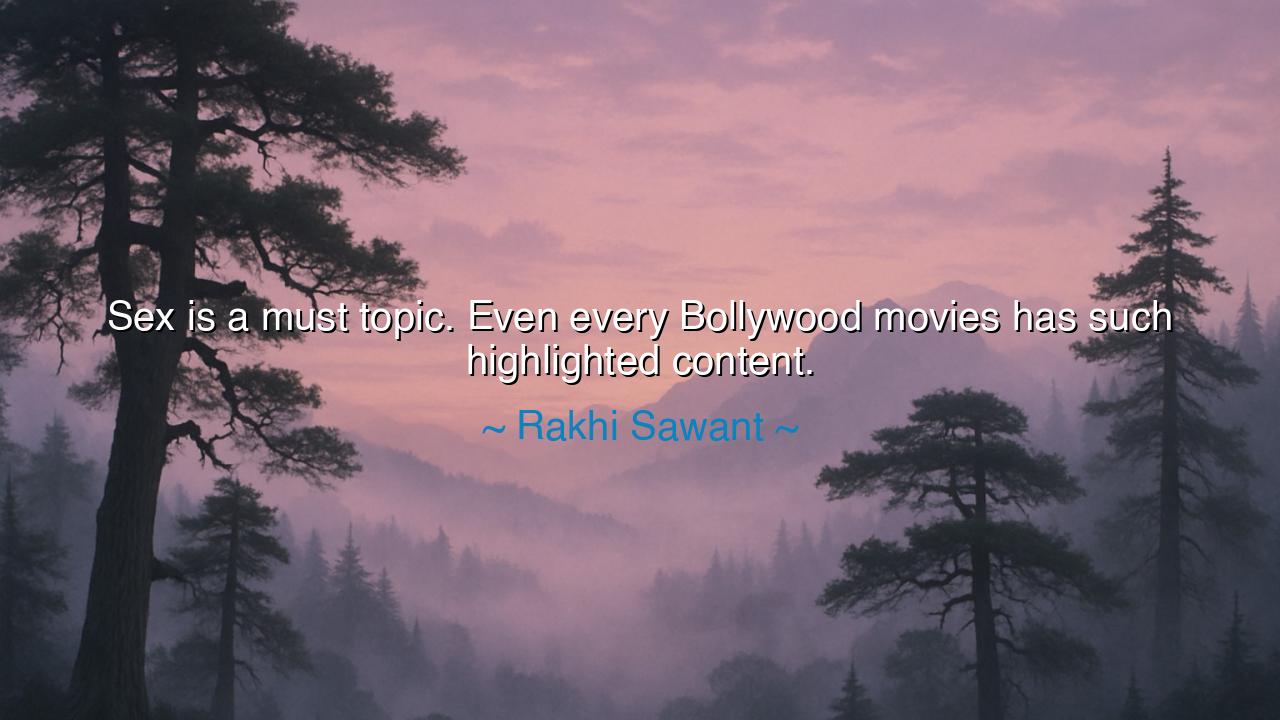
Sex is a must topic. Even every Bollywood movies has such






When Rakhi Sawant declared, “Sex is a must topic. Even every Bollywood movies has such highlighted content,” she gave voice to a truth that has echoed through the centuries, though often whispered behind closed doors rather than spoken aloud. Her words remind us that sex, far from being a trivial or shameful subject, is woven deeply into the fabric of human existence, and because of this, art, literature, and cinema cannot ignore it. By pointing to Bollywood movies, she reveals how even in cultures that outwardly guard modesty, desire and intimacy find their way onto the stage of storytelling, dressed sometimes in song, sometimes in metaphor, and sometimes in open display.
The origin of this truth lies in the eternal bond between art and human passion. From the carvings on the walls of Khajuraho in India, to the verses of the Kama Sutra, to the myths of gods and mortals in Greece, the subject of sex has always been present in art. Why? Because it is not only about the body, but about longing, power, creation, and vulnerability. Rakhi Sawant’s words, though provocative in tone, echo an ancient recognition: that to avoid the topic is to deny a fundamental aspect of life. Cinema, as the modern temple of storytelling, must inevitably grapple with it, for audiences are drawn to the truths that lie within desire.
Consider the story of Bollywood itself. In the early decades, when Indian cinema was under stricter codes of morality, sex was not shown directly. Instead, it was expressed symbolically—through flowers touching, through monsoon rains, through dances filled with longing. Yet as time passed, filmmakers dared to show more directly what had always been implied. Today, as Sawant notes, nearly every film highlights some element of sexuality—whether in love songs, item numbers, or in the emotional arcs of characters. The unspoken has become spoken, for the truth could no longer remain hidden.
The meaning of her statement is also a challenge. Sawant confronts a society that often cloaks sexuality in taboo while simultaneously consuming it eagerly in its art. By calling sex a “must topic,” she pushes against hypocrisy, insisting that if we are to understand ourselves, we must speak openly, without fear. For it is not the silence that purifies a subject, but the light of honest discussion. When sex is hidden, it breeds shame and ignorance; when it is acknowledged, it can be understood as part of the wider human journey of love, responsibility, and creation.
The lesson for us is profound: do not dismiss or belittle those aspects of life that are universal. Instead, confront them with maturity and wisdom. If cinema and art dare to portray sex, it is because it reflects a truth of the human heart—our longing for connection, our struggle with temptation, our search for intimacy. To deny its existence in culture is to deny our own humanity. But to engage with it wisely is to elevate it, transforming it from mere spectacle into a mirror of who we are.
What, then, should you do? First, cultivate honesty in your own life when it comes to subjects often wrapped in taboo. Second, as a viewer of art, seek the deeper meanings beneath the portrayals of desire—what do they reveal about love, about power, about society’s struggles? Third, if you are a creator, use these themes not to exploit but to illuminate, showing both the dangers of lust without love and the beauty of intimacy that is sacred and true.
Thus, let Rakhi Sawant’s bold words echo: “Sex is a must topic.” They are not merely scandalous, but deeply human. For the ancients carved it in stone, poets sang it in verse, and filmmakers project it on the screen, knowing it cannot be erased from the human story. It is for us, then, to approach it not with fear nor with frivolity, but with wisdom—acknowledging that in this subject lies both the fragility and the greatness of mankind.






AAdministratorAdministrator
Welcome, honored guests. Please leave a comment, we will respond soon